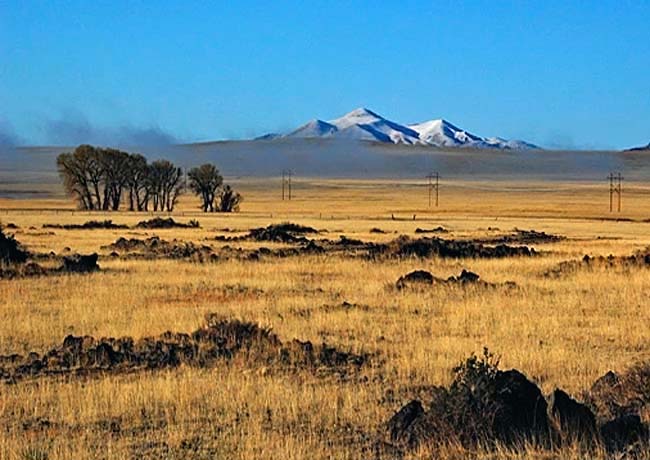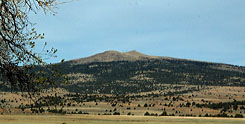|
Scenic USA - New Mexico Clayton-Raton Volcanic Field |

| Photos by Ben Prepelka Scenic USA FAA Photography |
Although it sounds extremely exciting to witness an erupting volcano first hand, most of us will be just as happy to view a well preserved and very dormant cinder cone. Here among the geological wonders of America's Southwest, New Mexico stands out as a land of extreme volcanism. Every type of volcanic land form, such as a shield volcano, composite volcano, cinder cone, volcanic caldera, pahoehoe lava and a'a' lava, is found in New Mexico.
Here in northeastern New Mexico, U.S. Route 64 cuts directly through the Clayton-Raton Volcanic Field. Littered with lava rock in all directions, mountains of volcanic origin are spread out over 1000 square mile area. Dating from 60,000 to one million years old, this volcanic field is comprised of 125 cinder cones and the largest shield volcano in northeast New Mexico. Easily seen from the highway, the andesitic Sierra Grande (inset) rises 2200 feet above the surrounding plain. Listed among the largest free-standing mountains in North America, the base of Sierra Grande  covers more than 65 square miles and rises to 8720 feet in elevation.
covers more than 65 square miles and rises to 8720 feet in elevation.
The highlight of a national monument, Capulin Volcano is probably the youngest cinder cone in the area, about 60,000 years old. Unlike the huge Sierra Grande, visitors may drive to the top of Capulin Volcano and hike into the cone.
Although the volcanoes here create a majestic skyline, it's much more fun to explore these wonders close-up. In this land of ancient volcanic chaos, picture yourself climbing inside a cinder cone, crawling through an ancient lava tube or marveling at one of the state’s ice caves.
Raton to Clayton - Map

|
Nearby Points of Interest |
Scenic USA Prints from
|
Copyright © 2022 Benjamin Prepelka
All Rights Reserved

